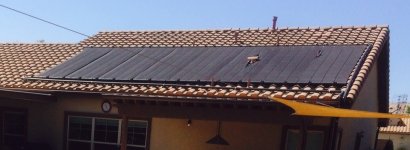My Pentair solar pool freeze protection seems to work well. Only a few freezes per year here. How is your system?In my mild climate, I don't close the pool for winter. But every winter, I drain my solar panels, leaving the drains open. This is to prevent freezing in the panels, which look pretty delicate with all those little tiny tubes through which water passes.
In my climate, we may get 2 or 3 nights a year when the temperature falls below freezing. But I sure don't want to damage those panels.
Now I have a new Pentair EasyTouch 8, which includes a setting for solar freeze protection (as well as main pump freeze protection) and the proper sensors for air, water, and solar temperatures. It would be more convenient to enable that than to drain the panels.
So my question is: have any of you used solar freeze protection on the EasyTouch, and did it work? Any panel damage, mold buildup, or other unintended consequence of not draining the panels?
Freeze protection for solar heater
- Thread starter ianriggall
- Start date
You are using an out of date browser. It may not display this or other websites correctly.
You should upgrade or use an alternative browser.
You should upgrade or use an alternative browser.
Welcome to TFP!
Freeze protection works, but I choose not to use it for my solar circuit. I run freeze protection at a slow speed, 850 RPM, just enough to keep things moving. My solar requires 2500 RPM to close the vacuum relief valves; anything slower and the valves leak. So I just drain the panels for winter.
Freeze protection works, but I choose not to use it for my solar circuit. I run freeze protection at a slow speed, 850 RPM, just enough to keep things moving. My solar requires 2500 RPM to close the vacuum relief valves; anything slower and the valves leak. So I just drain the panels for winter.
Don't take a chance on a very expensive repair. Shut the solar off and drain the panels.My Pentair solar pool freeze protection seems to work well. Only a few freezes per year here. How is your system?
- Nov 12, 2017
- 11,868
- Pool Size
- 12300
- Surface
- Plaster
- Chlorine
- Salt Water Generator
- SWG Type
- Pentair Intellichlor IC-40
When I installed my solar panels, I used a great tip I found in the instructions I was using (off the 'net). They recommended rotating the panels a slight amount, such that they didn't run exactly parallel to the ridge of the roof. In addition to the small vertical tubes sloping downhill (due to the slope of the roof), this skew of the panels makes the horizontal manifolds slope slightly downhill, too. I put the same skew into all the pipes running to and from the panels, as well. So when my pump shuts down, my panels drain completely, and no water gets trapped at one end of the panels or the pipes.
Without this skew, I'd be concerned about the water left in the panels, and would maybe try blowing them out. If you think your panels might be trapping water, that's something to consider. A small layer of water in the bottom of the manifolds or pipes shouldn't be an issue, only if you think a pipe or manifold remains mostly full.
That said, I agree with the others above. "Winterize" your panels by draining them the best you can and run water for freeze protection only through the rest of your plumbing.
Without this skew, I'd be concerned about the water left in the panels, and would maybe try blowing them out. If you think your panels might be trapping water, that's something to consider. A small layer of water in the bottom of the manifolds or pipes shouldn't be an issue, only if you think a pipe or manifold remains mostly full.
That said, I agree with the others above. "Winterize" your panels by draining them the best you can and run water for freeze protection only through the rest of your plumbing.
- Nov 12, 2017
- 11,868
- Pool Size
- 12300
- Surface
- Plaster
- Chlorine
- Salt Water Generator
- SWG Type
- Pentair Intellichlor IC-40
You can almost make out the skew of my panels relative to the roof tiles, but it's there. The skew is more obvious in the supply pipe just below the panels. While this skew works well for draining, it also serves a more important function. Because of the skew, my panels fill from the lower left and then the water exits from the upper right. The skew ensures that no water or air lingers in the upper left or lower right corners, which would impact the heating efficiency. There are some great animations on this webpage that explain this better:

 www.h2otsun.com
www.h2otsun.com
I doubt there is much to be done about this now, though it's possible if you were very ambitious. But if you ever replace your panels, or install them on the next home, keep this in mind.


Plumbing a Solar Pool Heater | Hot Sun Solar Pool Heating
The basic concepts you must know to correctly plumb a solar pool heater.
 www.h2otsun.com
www.h2otsun.com
I doubt there is much to be done about this now, though it's possible if you were very ambitious. But if you ever replace your panels, or install them on the next home, keep this in mind.

Last edited:
Thread Status
Hello , This thread has been inactive for over 60 days. New postings here are unlikely to be seen or responded to by other members. For better visibility, consider Starting A New Thread.

